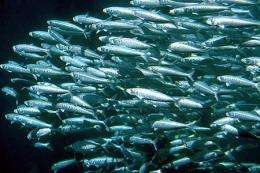Fish skin structure explains biological cloaking

The highly effective optical means by which silvery fish, such as the European sardine and Atlantic herring, camouflage themselves from predators is explained this month in Nature Photonics.
Reflective surfaces polarize light, a phenomenon that fishermen or photographers overcome by using polarizing sunglasses or polarizing filters to cut our reflective glare. However, PhD student Tom Jordan from the Bristol Centre for Complexity Sciences and his supervisors Professor Julian Partridge and Dr Nicholas Roberts in Bristol's School of Biological Sciences found that these silvery fish have overcome this basic law of reflection – an adaptation that may help them evade predators.
Previously, it was thought that the fish's skin – which contains "multilayer" arrangements of reflective guanine crystals – would fully polarize light when reflected. As the light becomes polarized, there should be a drop in reflectivity.
The Bristol researchers found that the skin of sardines and herring contain not one but two types of guanine crystal – each with different optical properties. By mixing these two types, the fish's skin doesn't polarize the reflected light and maintains its high reflectivity.
Dr Roberts said: "We believe these species of fish have evolved this particular multilayer structure to help conceal them from predators, such as dolphin and tuna. These fish have found a way to maximize their reflectivity over all angles they are viewed from. This helps the fish best match the light environment of the open ocean, making them less likely to be seen."
As a result of this ability, the skin of silvery fish could hold the key to better optical devices. Tom Jordan said: "Many modern day optical devices such as LED lights and low loss optical fibres use these non-polarizing types of reflectors to improve efficiency. However, these man-made reflectors currently require the use of materials with specific optical properties that are not always ideal. The mechanism that has evolved in fish overcomes this current design limitation and provides a new way to manufacture these non-polarizing reflectors."
More information: 'Non-polarizing broadband multilayer reflectors in fish' by T.M. Jordan, J.C. Partridge and N.W. Roberts in Nature Photonics, DOI: 10.1038/nphoton.2012.260
Journal information: Nature Photonics
Provided by University of Bristol




















